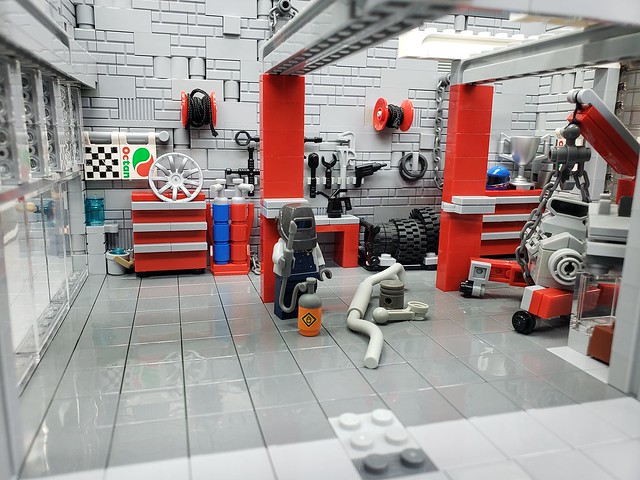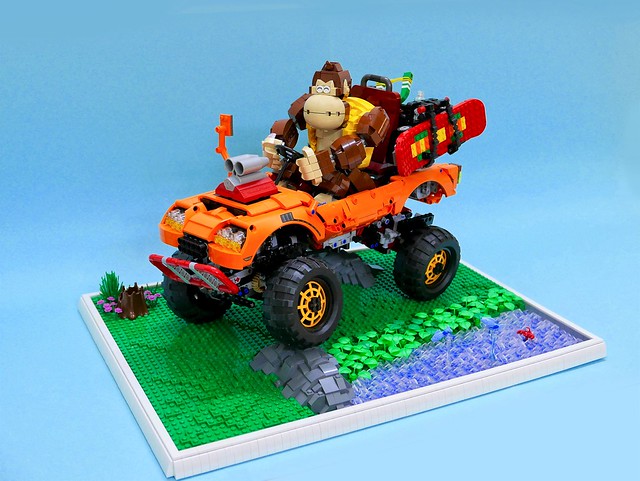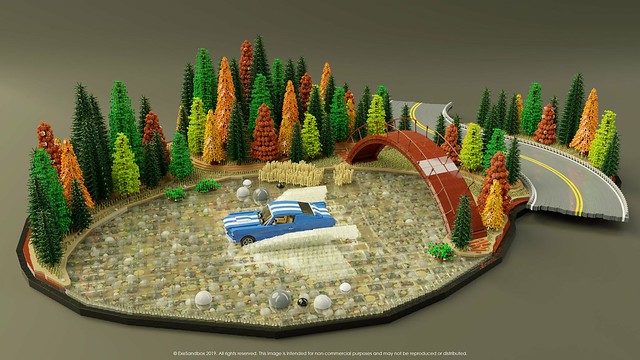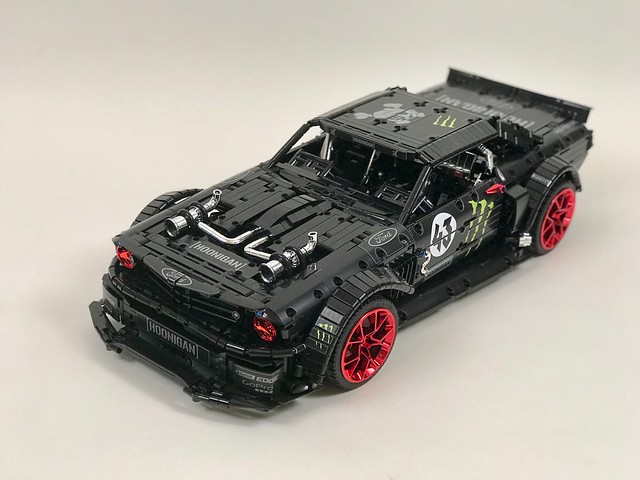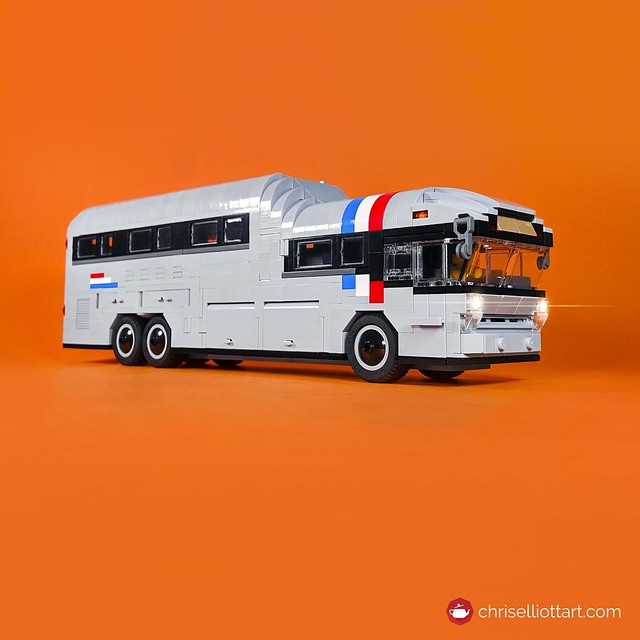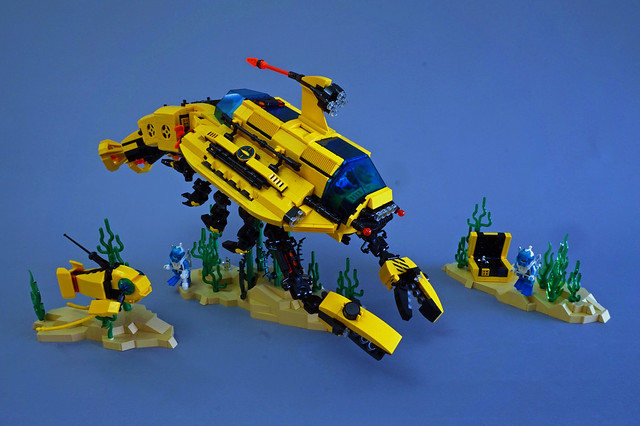Some of us here at the Brothers Brick are big fans of car builds. Yet, every good car needs an equally good auto repair shop to continue running, and this LEGO scene built by Ben Pitchford fits the bill. It has all the tools to get your motor running and on the highway. You can even beef up your favorite ride with the monster of an engine peeking out from the right. Best of all, everything is framed within an immersive, self-contained image. Columns and beams extending forward make you feel like you’re a part of the crew, so much so that you can almost smell the gasoline.
Tag Archives: Vehicles
This motorhead is monkeying around!
Builder Vincent Kiew presents his latest LEGO creation combining both System and Technic, and it’s an eye-catching racing scene that features a grinning gorilla gear-shifting through the grass!
There’s a convenient storage crate in back for all the accessories needed for an afternoon joyride around the jungle in the off-road racer. Continue reading
Just cruising on the lake in my Ford Mustang
In this incredibly detailed digital build, ExeSandbox was tasked to put a 1965 Ford Mustang in beautiful scenery. I think nobody told him it was supposed to be placed on a road, but the builder just slapped it straight in the middle of the scenery. And it looks amazing! Never before has a car driving on water looked so right.
The centerpiece of the scene is the quite accurate Ford Mustang, and it really gives the scene context. But it is the landscaping that shines here. There is a lot of simple parts that just work really well, like trees built of stacked leaf pieces or the clean layers of the ground. On the other hand, there are also very intensely textured trees with plates facing all directions and an extremely realistic lake bed covered in rocks. The water benefits the most from computer rendering, as finding this many perfectly clean translucent panels and placing them this straight without bending would be nearly impossible. What does not benefit from computer rendering is the perfect curved road though. While this technique looks beautiful and requires a proportional amount of work in real life, the builder states that it was a nightmare to do digitally, reminding us all that digital builders face their own challenges (the whole scene contains over 90,000 pieces). Often skeptics see digital builds as cheating or an easy shortcut, but the naysayers are often people who have never opened a brick-building program. And below is the final piece of art with a full background, and we can all agree that digital or not, the end result is a stunning image. And sometimes that is what matters.
Getting the ball rolling
Never underestimate the power of a good color scheme. This gorgeous orange, teal, and white racer by Chris Perron is instantly eye-catching thanks to its bold shades. The car isn’t just all flash, though, as it’s designed as a futuristic mag-lev vehicle around a large rear ball, held in place with a pair of orange basketball hoops. The ball originally hails from Duplo, and it’s one of only a few elements to have successfully made the jump from Duplo to System sets. The use of 3×3 radar dish pairs for front “wheels” also works great (do mag-lev cars need wheels?).
I see that rims and I want them colored (chrome) red
Ken Block’s 1,400hp AWD Ford Mustang Hoonicorn is not your ordinary GT Fastback from the 1967 model year, even though both cars still got the body of a 1965 Mustang. A huge fan of LEGO cars, lachlan cameron, skilfully captures the car’s wild design with a ton of LEGO Technic liftarms and panels. No need to say, the result is just stunning, but these jaw-dropping red chrome rims is where the car really shines. Custom LEGO pieces can contribute a lot to any build’s final appearance, and in this case the rims create the Mustang’s character. But don’t forget to check out the rest of the chrome parts, as well as a whole bunch of custom stickers that make the LEGO version almost a perfect scale copy of the real car.
This wild Mustang is the Boss of the canyon
Collaborative building projects can yield amazing results, such as this slick 1969 Ford Mustang Boss 302 overlooking a picturesque cliff. The bright red Mustang was built by ham_MOC, while the cliff was built by Jonathan S. If you didn’t know this was a collaboration, you might think everything was made by one person. That’s because the two builds pair nicely, complete with advanced coloring techniques like the Mustang’s two-tone exterior and the layering of colors on the cliff. It makes for a cohesive build that couples American muscle with the beauty of the American West.
The two builders built this colorful vignette for the LEGO Ideas contest, “Celebrate your favorite Ford Mustang in a beautiful scenery!”
A rustic barn with a classic Ford Mustang
Some LEGO builders say that architecture and scenery merely exist to serve as backdrops for cars or trains. Looking at this display built by Andrea Lattanzio, I beg to differ. While the classic first-series Mustang Hardtop is beautiful on its own, the barn behind it is equally delightful. Andrea achieved the barn’s dilapidated look through effective use of brown and dark grey tiles, which are not pressed down all the way. Personally, I find it difficult to ignore the satisfying feeling of pressing two LEGO pieces together but, when they’re tilted just a little and with varying degrees, the rustic charm is undeniable.
Other highlights include the rusty broken gas pump and an American flag, which is cleverly formed out of plates with clips in such a way that makes it look as if it’s waving in a light breeze. The car itself cannot be overlooked; the lines are sleek and the construction is smooth. Curved slopes on the hood are ideal parts in creating the perfect angle, and the use of clear slopes for the windshield is simple but feels representative of a real Mustang.
Classic Space, roved by rovers for 40 years
Brickshelf user (yes, Brickshelf still exists) legofrik has recently built a cute boxy rover in the colours of Classic Space. He says the inspiration was a coincidental discovery that small treads fit around 6×6 dishes to create a unique wheel design.
The build has a very boxy shape, and yet avoids looking rectangular and simple. The colours are not only blocked visually, but also by purpose; blue as the main bulk of the vehicle, gray for radars, hoses and other technical doodads and translucent yellow as the iconic Classic Space window and windscreen colour. The rover also has working suspension and a detailed interior.
A bookmobile to behold
Some vehicles are more than meets the eye. While this 1959 Salem Ameriliner Library Bus by Chris Elliott doesn’t change into a walking, talking robot, it has been transformed on the inside, from a passenger carrier to mobile library with a fully detailed interior. Even without the interior, the bus is a beautiful creation. The combination of slopes used on the roof place it indisputably in the 1950s, and the other details are seamless: doors on their side as luggage compartment doors and zip line handles as side view mirrors.
If you’re not impressed by the exterior, open it up and be prepared to be blown away. The interior of this bookmobile is spot on to the last detail. It starts with enough books to actually be called a library, stowed everywhere they could possibly go: on the walls, in the luggage compartment, and even in the floor. There’s even a comfy couch in the back to curl up with whatever good book you’ve found on the shelf!
Continue reading
A small fire engine for a large city
Home to almost 40 million people, greater Tokyo is the world’s most populous metropolitan area. Space is at a premium, so houses tend to be small and built closely together. To fight fires in the dense urban areas, the Tokyo Fire Department has a large fleet of exceedingly small fire engines. They are narrow enough to fit the streets between the houses. They also have a relatively short wheelbase, so that they can navigate tight corners. In preparation for a visit to Japan Brickfest later this year, I’m building a small collection of Japanese emergency vehicles. I’ve been looking forward to building the fire engine the most, so I’ve kept that for last.
At a first glance, it may not look all that small, especially if you are used to LEGO minifigure-scale builds. However, if you compare the pumper to the two fire fighters, it is obvious that it is a lot smaller than pumpers from Europe or the US. It is only about as wide as a typical American car and not all that much longer. Nonetheless, it has everything you’d expect from its larger counterparts and a little more. It is nice and red, obviously. It has pump control panels with connections for fire hoses, a few ladders stored on top and lots of compartments for tools. Typical for Japanese pumpers, it also houses a little separate wheeled cart in the back. Fire fighters use this to transport hoses down even narrower alleys. The model is like a miniature version of a miniature fire engine.
Dive deep with the return of Aquazone
LEGO fan Tim Goddard is perhaps best known for his space-themed builds, such as this microscale space station we shared in February. Building off of his intergalactic experience, Tim is now diving below the seas to revisit the classic mid-1990s Aquazone theme. The centerpiece here is a large submersible, cleverly designed to look like a lobster. Instead of building the sub in lobster red, Tim went with the iconic yellow, black, and neon orange livery of the Aquanauts. By combining a mix of period-correct parts and more modern elements, Tim has created a submarine that feels both modern and true to the original source material. Meanwhile, an adorable fishy “drone” makes for a fine finishing touch.
Attention all Rock Raiders! This is not a drill!
Twenty years after its inception, the often-overlooked yet undeniably cool LEGO Rock Raiders theme finds its way into fan creations as well. In February we featured a collection of vehicles built in honour of this theme, and now it’s Chris Perron‘s turn to show off his gritty tunneling hovercraft, with all its glorious teal and chrome highlights. Chris notes that this creation is actually a year and a half old, but was inspired by friends to give the tunneler a base and finally upload it.
The base is a convincing cutout of a rock tunnel, dotted with chrome green crystals (these crystals actually come from the Space Port line from the same year–Rock Raiders featured trans-neon green crystals), and it’s perfect place to show off this cute little drilling drone. The drone itself is quite a perfect representation of its theme. The colour combination has all the characteristics of Rock Raiders; teal highlights, black and yellow warning stripes, a brown rollcage and grays as the main colour. What is especially impressive is the complex drilling head in the front, built of various custom chrome elements.
